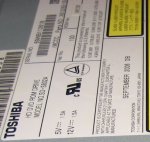I had heard anecdotally that the PHR-803T was from the HD-DVD drive for a Microsoft XBOX360, that it was used in an earlier version of this drive, and that a later version used a different/less powerful sled/laser diode?
Doing some research, I also came across an external HD-DVD drive for the XBOX360 that appears to have been released around Nov. 2006? -
http://www.engadget.com/2006/10/17/xbox-hd-dvd-drive-to-connect-to-pcs-via-usb/
and that was actually based on a Toshiba drive, model SD-S806A, one unit of which had a manufacturing date of Sept. 2006 -
http://uneasysilence.com/archive/2006/11/8303/
http://achernob.blogspot.com/2007/04/mounting-xbbox-360-hd-drive-into-my-pc.html
Is this all correct?
Is the PHR-803T the sled for the first version of the XBOX360 HD-DVD Drive that was released ~Nov. 2006?
Is it, in fact, the sled from the Toshiba SD-S806A Drive?
Does anybody have any information on the design or manufacturing dates on the PHR-803T sleds we are using to make 405nm burners?
Thanks!
Doing some research, I also came across an external HD-DVD drive for the XBOX360 that appears to have been released around Nov. 2006? -
http://www.engadget.com/2006/10/17/xbox-hd-dvd-drive-to-connect-to-pcs-via-usb/
and that was actually based on a Toshiba drive, model SD-S806A, one unit of which had a manufacturing date of Sept. 2006 -
http://uneasysilence.com/archive/2006/11/8303/
http://achernob.blogspot.com/2007/04/mounting-xbbox-360-hd-drive-into-my-pc.html
Is this all correct?
Is the PHR-803T the sled for the first version of the XBOX360 HD-DVD Drive that was released ~Nov. 2006?
Is it, in fact, the sled from the Toshiba SD-S806A Drive?
Does anybody have any information on the design or manufacturing dates on the PHR-803T sleds we are using to make 405nm burners?
Thanks!





